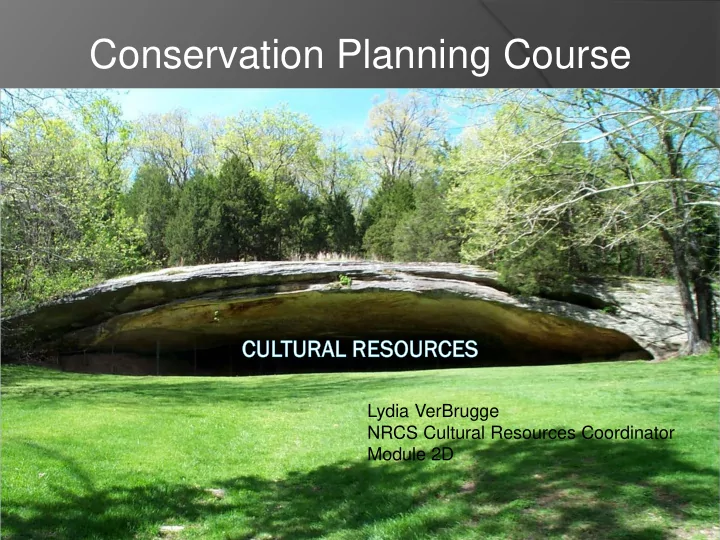

Conservation Planning Course Lydia VerBrugge NRCS Cultural Resources Coordinator Module 2D
National Historic Preservation Act What is Section 106? The head of any Federal agency having direct or indirect jurisdiction over a proposed Federal or federally assisted undertaking in any State and the head of any Federal Department or independent agency having authority to license any undertaking shall, prior to the approval of the expenditure of any Federal funds on the undertaking or prior to the issuance of any license , as the case may be, taking into account the effect of the undertaking on any district, site, building, structure, or object that is included in or eligible for inclusion in the NRHP. The head of any such Federal agency shall afford the ACHP established under Title II of this Act a reasonable opportunity to comment with regard to such undertaking.
APE Considerations (Area of Potential Effect) The geographic extent of ground disturbing practice Movement of machinery Point of access Impact on surroundings Removal and disposal of debris Can be an “area” or “areas”
Cultural Resources are considered as a part of the Environmental Analysis for Conservation Planning The form used to document this consideration is the CPA-52
Cultural Resources on CPA-52 Review “comment box” for more information
Cultural Resources on CPA-52 Guide Sheet and Fact Sheet (national info) Ground Disturbing Practice List (Missouri) Links to FOTG Brings up list in pdf format MO CR-1 Complete when ground disturbing practice is planned
Cultural Resources on CPA-52 No Action: NA (typically) Alternative without ground disturbing potential: No ground disturbing practice planned. Alternative with ground disturbing potential: Ground disturbing practice planned. See Section I and attached form CR-1 for details. (Also, check “needs action” box).
CR-1 Basic Information Historic Property Review Discussion with Owner/Operator Field Inspection
Section L - Mitigation Ground disturbing practice planned. See Section L and attached form CR-1 for details.
CR Mitigation Statement Examples Alternatives that had ground disturbing potential: National Register Property out of APE Archaeological site out of APE Avoided archaeological site by moving planned practice New archaeological site documented and avoided
Document on CPA-52 Request for Assistance Proceed with NO File in Case File Assistance Is the Practice an Undertaking Field Office Completes YES the Cultural Resources Worksheet NO Are there any known sites Document findings on the (including the field YES Cultural Resources Worksheet inspection) (all items must be completed) File in Case File Request site NO information from CRC NO Did the Review and Is the known site(s) in the APE Inspection find any cultural resources in the YES YES Area of Potential Effect (APE) Request assistance from the CRC to relocate the site and develop options
FOTG
FOTG – Section II E 7 Sections
FOTG – Section II E 1 National Register Listings in Missouri
FOTG – Section II E 2 NRCS Instructions and Policy – MO GM Supplement Missouri Law •Felony to alter a burial site without proper authorization or not to follow regulations if human remains are uncovered in the course of ground disturbing activities. •Protects private cemeteries – penalties for anyone who knowingly destroys, disfigures, removes, etc., any tomb, monument, or gravestone in such cemeteries. Administrative Responsibilities •Area Conservationists designate Area Cultural Resources Coordinators (ACRCs) •Area Cultural Resources Coordinators provide assistance to field offices when cultural resources have been identified •Cultural Resources Specialist duties •Cultural Resources Coordinator duties Undertaking List Maintenance
FOTG – Section II E 3 Directory of Contacts Coordinator Map Link to SHPO
FOTG – Section II E 4 Projectile Drawings and Photos PROJECTILE POINT MORPHOLOGY
FOTG – Section II E 5 Ground Disturbing Practice List (Undertaking)
FOTG – Section II E 6 DNR Archaeological Site Form
FOTG – Section II E 7 Cultural Resources Worksheet MO-CR1
Example Training Field Yellow = documented archaeological site Purple = APE Blue star = artifacts found during pedestrian survey
What Do You Need to Know? Be familiar with the history of where you’re working. Talk to landowners! They take interest in the history of their property. Realize that flexibility is important in the planning process. Ask for assistance early so we can follow the law, protect our resources, and complete necessary documentation. Process in place to comply with programmatic and state level agreements
Training Cultural Resources Modules 1-6 on AgLearn Add to your training plan at any time Takes 2-4 hours Required before taking Modules 7/8 Cultural Resources Modules 7/8 Classroom instruction Field instruction Usually offered annually Cultural Resources Module 9
Recommend
More recommend